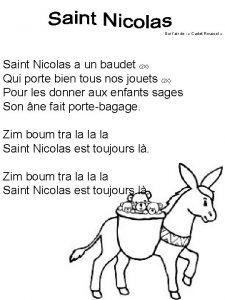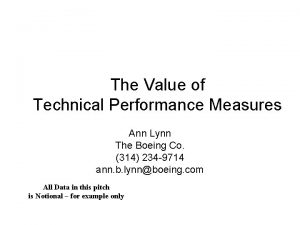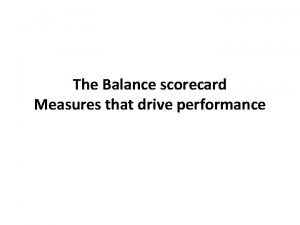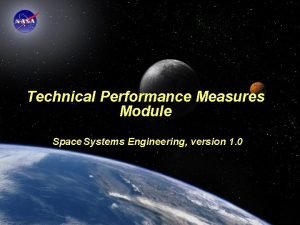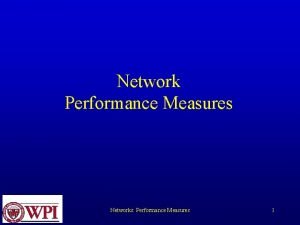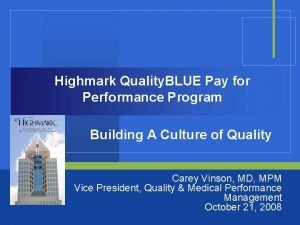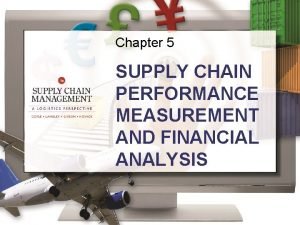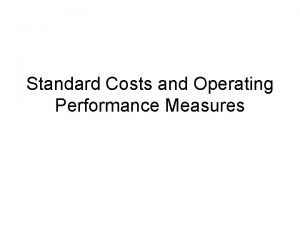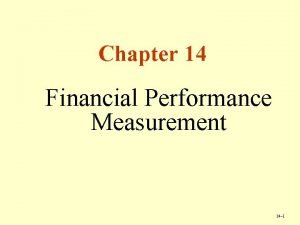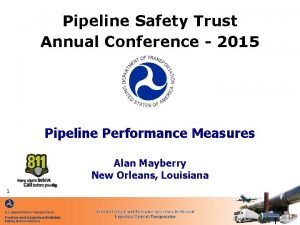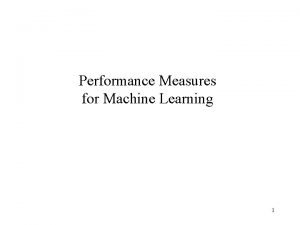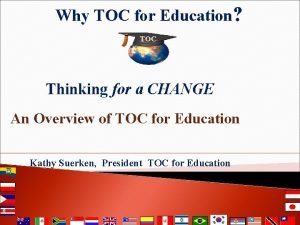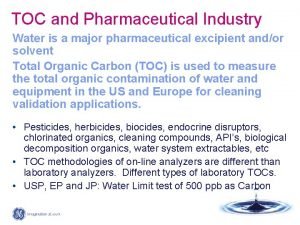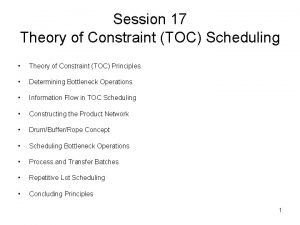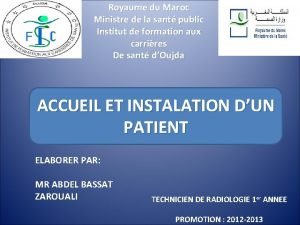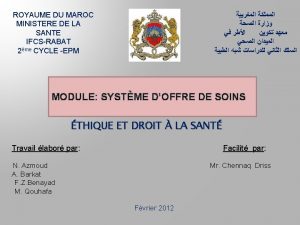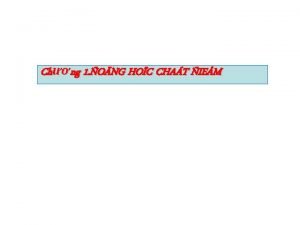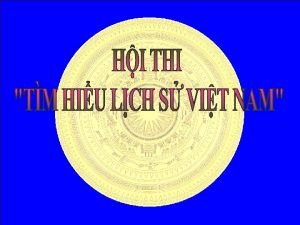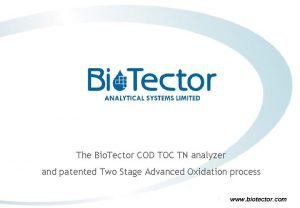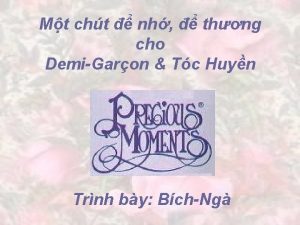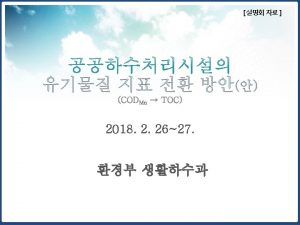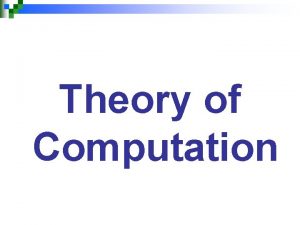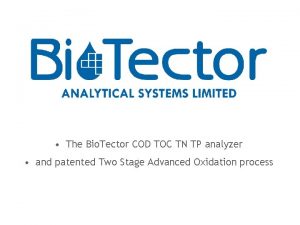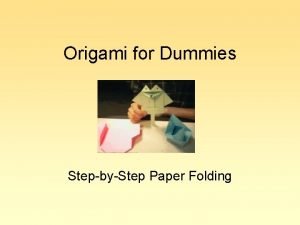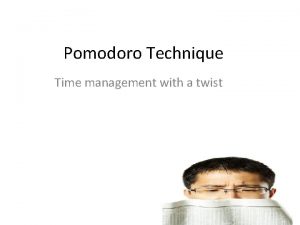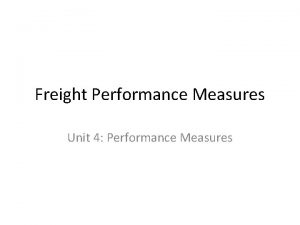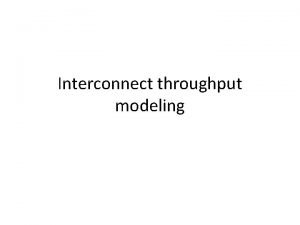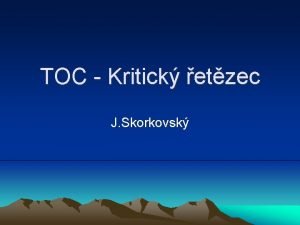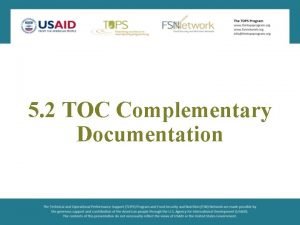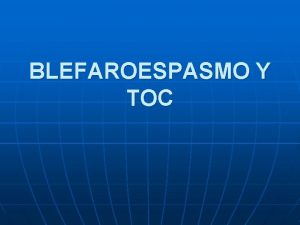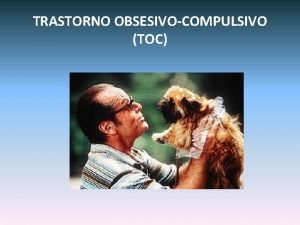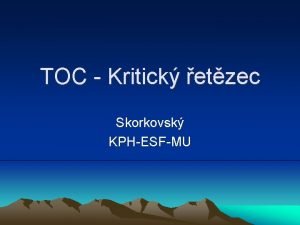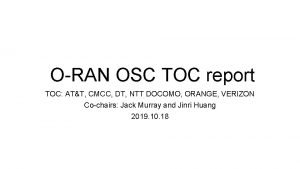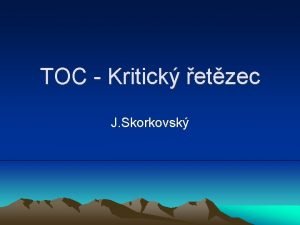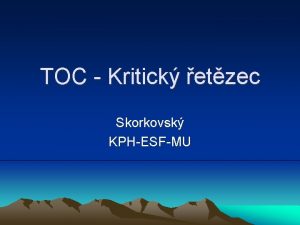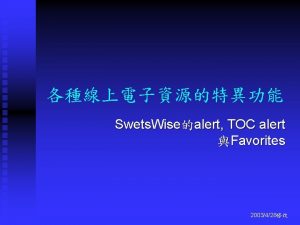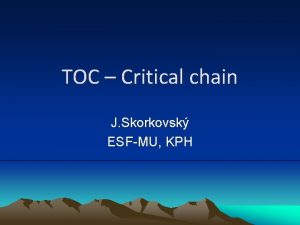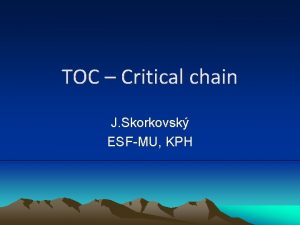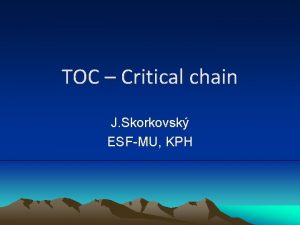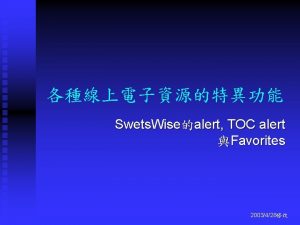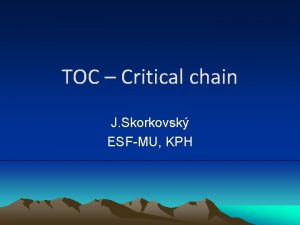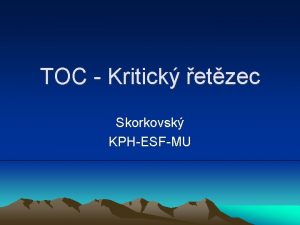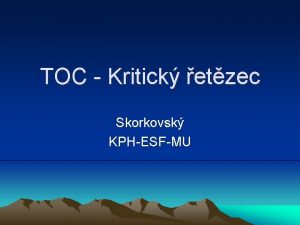Throughput World TOC Performance Measures p Throughput T






























- Slides: 30

Throughput World

TOC Performance Measures p Throughput (T): The rate at which the system generates money through sales. Sales – Row Material and Component costs. p Inventory (I): All the money invested in purchasing things needed by the system to sell its products. Raw Material, WIP, and Finished Goods inventory as well as capital resources owned. p Operating Expenses (OE): All the money the system spends, turning inventory into throughput. Direct labor, Administrative and Non Administration overhead, Depreciation. Theory of Constraints: 2 - Throughput World Ardavan Asef-Vaziri Nov-2010 2

Bottom Line Measures T = Sales Revenue - Variable Cost (Materials) OE = Fixed Costs (Direct Labor + Overhead) NET PROFIT (Absolute) RETURN ON INVESTMENT (Relative) CASH FLOW (Survival) Theory of Constraints: 2 - Throughput World Ardavan Asef-Vaziri Nov-2010 3

Priorities in Traditional World First: OE Second: T Distant Third: I Theory of Constraints: 2 - Throughput World Ardavan Asef-Vaziri Nov-2010 4

Where is the Bang for the Buck? (T vs. OE) $ Leverage from Decreasing OE Increasing T Revenue 100 RM 40 DL 10 OH 40 Cost 90 NP 10 100 40 88 114 0. 95(100) = 48 95 10 1. 20(95) = 40 114 98 12 16 Assume a) you have 20% excess capacity, and b) sales will increase by 20% if you can effect a 5% price reduction. Theory of Constraints: 2 - Throughput World Ardavan Asef-Vaziri Nov-2010 5

Shifting Paradigms First: Second: Third: Current Priority OE New Priority T T I I OE Theory of Constraints: 2 - Throughput World Ardavan Asef-Vaziri Nov-2010 6

TOC/Lean Principle Decisions should promote a growth strategy. While enterprises should attempt to simultaneously increase throughput, decrease inventory, and decrease operating expenses, the focus must be on improving throughput. Five-Step Focusing Process: An Example. A small production system for manufacturing two products, P and Q. Goal is to maximize profit. Weekly demand for P is 110 units & for Q is 60 units. Four resources used to meet demand: A, B, C, and D Theory of Constraints: 2 - Throughput World Ardavan Asef-Vaziri Nov-2010 7

Practice; Follow the 5 Steps Process P: $90 / unit 100 units / week Q: D 5 min. D 15 min. Purchased Part $5 / unit C 10 min. A 15 min. RM 1 $20 per unit $100 / unit 50 units / week C 5 min. B 15 min. RM 2 $20 per unit B 15 min. A 10 min. RM 3 $20 per unit Time available at each work center: 2, 400 minutes per week. Operating expenses per week: $6, 000. All the resources cost the same Theory of Constraints: 2 - Throughput World Ardavan Asef-Vaziri Nov-2010 8

Can We Meet The Demand? Operating expenses per week: $6, 000. Available time / week on each resource: 2400 min. All Resources cost the same. Theory of Constraints: 2 - Throughput World Ardavan Asef-Vaziri Nov-2010 9

Can We Meet The Demand? Resource requirements for 100 P’s and 50 Q’s: p Resource A: 100 x 15 + 50 x 10 = 2000 minutes p Resource B: 100 x 15+ 50 x 30 = 3000 minutes p Resource C: 100 x 15+ 50 x 5 = 1750 minutes p Resource D: 100 x 15+ 50 x 5 = 1750 minutes Theory of Constraints: 2 - Throughput World Ardavan Asef-Vaziri Nov-2010 10

Any Bottlenecks? p B is a bottleneck. p A, C, & D are not bottlenecks. p We cannot achieve desired levels of production due to the capacity constraint on B. p What production levels do we set for P & Q? Theory of Constraints: 2 - Throughput World Ardavan Asef-Vaziri Nov-2010 11

The Production Decision So, Q is the star and P is the “dog. ” First we’ll offer the star to the market. If we have residual capacity, we’ll offer the dog! Okay? Theory of Constraints: 2 - Throughput World Ardavan Asef-Vaziri Nov-2010 12

What Is The Net Profit? For 50 units of Q, need 50 x 30 = 1500 min. on B, leaving 900 min. on B, for product P. Each unit of P requires 15 minutes on B. So, we can produce 900/15 = 60 units of P. If we sell 50 units of Q and 60 units of P, we get 50 x $60 + 60 x $45 = $ 5700 per week. After factoring in operating expense ($6, 000), we LOSE $300! Theory of Constraints: 2 - Throughput World Ardavan Asef-Vaziri Nov-2010 13

Do We Shut The Plant Down? p Is this a “throughput world” perspective? § We dealt with “product profits. ” Are there any product profits in the throughput world? p What is the second focusing step? p DECIDE HOW TO EXPLOIT THE CONSTRAINT. p Link the goal of the subsystem to the goal of the total system. Measure the performance of the subsystem based on the performance of the total system. Theory of Constraints: 2 - Throughput World Ardavan Asef-Vaziri Nov-2010 14

Constraints Decision Variables x 1 : Volume of Product P x 2 : Volume of Product Q Resource A 15 x 1 + 10 x 2 2400 Market for P x 1 100 Resource B 15 x 1 + 30 x 2 2400 Market for Q x 2 60 Resource C 15 x 1 + 5 x 2 2400 Objective Function Maximize Z = 45 x 1 +60 x 2 -6000 Resource D 15 x 1 + 5 x 2 2400 Theory of Constraints: 2 - Throughput World Nonnegativity x 1 0, x 2 0 Ardavan Asef-Vaziri Nov-2010 15

Excel, Solver, Internal Constraint (Capacity), External Constraint (Market) Theory of Constraints: 2 - Throughput World Ardavan Asef-Vaziri Nov-2010 16

Throughput World vs. Cost World p The cost world perspective had indicated that we should first focus on producing product P. p The throughput world perspective indicates that we should first focus on producing product Q. Theory of Constraints: 2 - Throughput World Ardavan Asef-Vaziri Nov-2010 17

Which Perspective Is Correct? p Produce P first: 100 / week. Requires 1500 minutes of B. Leaves 900 minutes to make Q. p Each Q requires 30 minutes on resource B. Can produce 900 / 30 = 30 units of Q. p With 100 units of P and 30 units of Q, we get 100 x $45 + x 30 $60 = $ each week. 6300 p After subtracting $6, 000 for operating expenses, we obtain a net profit of $300 Theory of Constraints: 2 - Throughput World Ardavan Asef-Vaziri Nov-2010 18

Value of the Resources Theory of Constraints: 2 - Throughput World Ardavan Asef-Vaziri Nov-2010 19

Step 4 p What is Step 4? n n p Elevate the System’s Constraints How does it affect us here? The Marketing Director Speaks Up : n “Another constraint in our company. ” p p It is the market A Great Market in Japan! n “Have to discount prices by 20%” Theory of Constraints: 2 - Throughput World Ardavan Asef-Vaziri Nov-2010 20

Do We Try To Sell In Japan? $/Const Minute 3 2 1. 8 1. 33 Theory of Constraints: 2 - Throughput World Ardavan Asef-Vaziri Nov-2010 21

Step 4 p p p p Right now, we can get at least $ 2 per constraint minute in the domestic market. So, should we go to Japan at all? Perhaps not. Okay, suppose we do not go to Japan. Is there something else we can do? Let’s buy another machine! Which one? B Cost of the machine = $100, 000. Cost of operator: $400 per week. What is weekly operating expense now? $6, 400 How soon do we recover investment? Theory of Constraints: 2 - Throughput World Ardavan Asef-Vaziri Nov-2010 22

New Constraints 100000/3000 = 33. 33 weeks 100000/(3000=300) = 37. 03 weeks Theory of Constraints: 2 - Throughput World Ardavan Asef-Vaziri Nov-2010 23

The Paradise Plant! IF: Clients never change their mind, Vendors always supply what we ask for, on time, Our workers are excellently trained, Our processes are extremely reliable, Our quality is superb, We do not have any absenteeism, Data is readily available and accurate, and You can decide on whatever policies you want. THEN: Managing production will be a piece of cake, … right? Theory of Constraints: 2 - Throughput World Ardavan Asef-Vaziri Nov-2010 24

Practice: The Modified Problem P: $90 / unit 110 units / week Q: $100 / unit 60 units / week D 5 min. D 10 min. Purchased Part $5 / unit C 10 min. A 15 min. RM 1 $20 per unit C 5 min. B 10 min. RM 2 $20 per unit B 25 min. A 10 min. RM 3 $25 per unit Time available at each work center: 2, 400 minutes per week. Operating expenses per week: $6, 000. All the resources cost the same Theory of Constraints: 2 - Throughput World Ardavan Asef-Vaziri Nov-2010 25

Step 1 : Identify the Constraint p Product contribution is selling price less the price of materials used in the product n n p Contribution of P = $90 - $5 - $20 = $45 Contribution of Q = $100 - $25 = $55 Cost World Analysis – work with product cost and product profits n n n Q has higher profit margin ($55) than P ($45) Q needs a total of 55 minutes compared to 50 for P With this approach, use the constraint to produce as many Q’s as possible and use remaining capacity to produce P Means producing 60 units of P (2100 minutes of Resource B), leaving 300 minutes which is enough to produce 30 units of P Product Mix results in a net profit of $45(30) + $55(60) - $6, 000 = $1, 350 Theory of Constraints: 2 - Throughput World Ardavan Asef-Vaziri Nov-2010 26

Step 2 : Decide How to Exploit the System’s Constraint(s) Decision Variables x 1 : Volume of Product P x 2 : Volume of Product Q Resource A 15 x 1 + 10 x 2 2400 Market for P x 1 110 Resource B 10 x 1 + 35 x 2 2400 Market for Q x 2 60 Resource C 15 x 1 + 5 x 2 2400 Objective Function Maximize Z = 45 x 1 +55 x 2 -6000 Resource D 10 x 1 + 5 x 2 2400 Theory of Constraints: 2 - Throughput World Nonnegativity x 1 0, x 2 0 Ardavan Asef-Vaziri Nov-2010 27

Exploit the Constraint Theory of Constraints: 2 - Throughput World Ardavan Asef-Vaziri Nov-2010 28

Step 3: Subordinate Everything Else to This Decision This step means keeping Resource B running at all times p We can first have Resource B work on raw material RM 2, during which Resource A would be processing 36 units of raw material RM 3 each week to produce product Q p If more than 36 units of A are produced, they would accumulate in front of Resource B p Theory of Constraints: 2 - Throughput World Ardavan Asef-Vaziri Nov-2010 29

Step 4 : Elevate the Constraint(s) The bottleneck has now been exploited Besides identifying Resource B as a bottleneck, we have found another: the Product Mix (water level effect) Ideally, we would like to have more demand for product P, but we have two choices p p p 1. 2. p Generate more demand for Product P Buy another Resource B Either way, we have elevated the constraint so we now have to execute steps 1 through 5 again. Theory of Constraints: 2 - Throughput World Ardavan Asef-Vaziri Nov-2010 30
 Comptine toc toc toc qui toque à la porte
Comptine toc toc toc qui toque à la porte Veux-tu briser du péché le pouvoir parole
Veux-tu briser du péché le pouvoir parole Repeated-measures design
Repeated-measures design Technical performance measures
Technical performance measures The balanced scorecard: measures that drive performance
The balanced scorecard: measures that drive performance Technical performance measure
Technical performance measure Network performance measurement in computer networks
Network performance measurement in computer networks Highmarl true performance quality measures
Highmarl true performance quality measures Financial measures of supply chain performance
Financial measures of supply chain performance Operating performance measures
Operating performance measures Starbucks financial objectives
Starbucks financial objectives Pipeline performance measures
Pipeline performance measures Performance measures for machine learning
Performance measures for machine learning Toc meaning school
Toc meaning school Toc in pharmaceutical industry
Toc in pharmaceutical industry Toc mérés
Toc mérés Toc scheduling
Toc scheduling Toc doc maroc
Toc doc maroc Toc doc maroc
Toc doc maroc Vận tốc góc
Vận tốc góc Anatel toc
Anatel toc Hai bà trưng
Hai bà trưng Bio toc
Bio toc Tóc demi garcon là gì
Tóc demi garcon là gì Toc 계산
Toc 계산 Noiafrem
Noiafrem What is a transition graph
What is a transition graph Tp analyzer
Tp analyzer Origami for dummies
Origami for dummies Kieran lamb
Kieran lamb Pomodoro etymology
Pomodoro etymology
